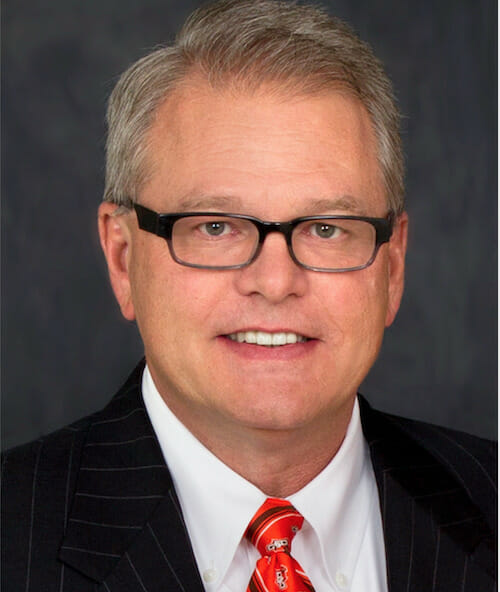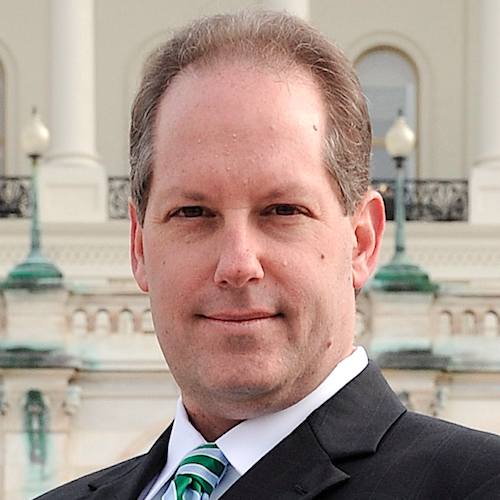
Senior living operators will continue to face inflationary pressures and capital market challenges in 2024, but some effects may lessen before the year is out, according to industry experts. Expect the workforce-related issues that have dogged providers for years to persist, however, they said.

“The elevated interest rates driven by the Federal Reserve efforts to bring down inflationary pressures had a profound impact on the sector in 2023,” National Investment Center for Seniors Housing & Care President and CEO Ray Braun told McKnight’s Senior Living.
Noting the “significant demographic wave on the horizon,” he said that the past year also saw record absorption of new senior housing inventory as it hit the market. “At the same time, we experienced a marked decline in new construction as well as transaction activity in 2023,” Braun said. “The lending environment and overall cost of capital has been prohibitive and has been a definite headwind.”
Capital still will be constrained early this year, he said, “but we are also hopeful that as the year progresses, we will start to see some improvement on this front.”
National Center for Assisted Living Executive Director LaShuan Bethea singled out inflation as the top issue faced by the industry over the past year.
“Inflation has caused soaring labor costs, in addition to other expenses, and made it difficult for assisted living providers to compete for caregivers,” she told McKnight’s Senior Living. “As a result, assisted living communities have been forced to use more contract nurses and staffing agencies, many of which are charging two or three times more than they charged prior to the pandemic.”
As 2024 dawns, Bethea said, the financial challenges will continue.
“Inflation makes all other expenses in assisted living more expensive, from food to cleaning supplies,” she said. “Additionally, the entire industry is still facing the ongoing ripple effects of skyrocketing costs from the pandemic.”
Assisted living providers, Bethea said, managed their COVID-19 response with little support from the government. According to some estimates, assisted living communities collectively received approximately $1 billion in relief funds, compared with the $12.5 billion received by nursing homes, despite the fact that assisted living providers serve about the same number of older adults and incurred more than $30 billion in pandemic losses and expenses.
“Federal and state policymakers provided little support to these communities in terms of personal protective equipment, testing and staff support,” she said. “Those COVID-related expenses continue today.”
Senior living providers, American Seniors Housing Association President and CEO David Schless said, continue to be confronted by “inflationary pressures across several key expense categories and a significant and rapid increase in interest rates.”
“Ultimately, the top challenge in 2023 was related to the capital markets and liquidity challenges,” he told McKnight’s Senior Living, adding that he expected those issues to continue this year.

“While inflationary pressures appear to be moderating somewhat, the interest rate environment and overall capital market environment for all real estate-based assets will likely remain challenging,” Schless said. “And we know there are many owners facing debt maturities in the upcoming year, which may prove to be extremely challenging with an ongoing liquidity crisis.”
NIC believes that the industry will reach an inflection point this year and that a “reset” will occur, Braun said.
“There will be some distressed inventory and underwater loans that the market is going to have to work through,” Braun said. “We think this reset is going to force a narrowing of the bid-ask spread and some reconciliation around equity contributions to stabilize outstanding debt.”
A ‘patchwork’ system
From a broader perspective, LeadingAge President and CEO Katie Smith Sloan told McKnight’s Senior Living, operators are challenged by “the shortcomings of our current patchwork system of delivering and financing long-term care.”
The association for nonprofit providers across the continuum of aging services is “doing all we can to raise up and urge policymakers and other stakeholders” to address the issue, she said.
“America is experiencing a massive demographic shift with implications for every aspect of society,” Sloan said. “Accessing quality long-term care is very often challenging, for many reasons. There is little political will to address these issues systemically, but policymakers are quick to criticize. Too often, aging services and providers are the scapegoat.”
Policymakers and members of the public must be educated about the industry as a whole as well as the differences between provider types, Sloan said.
“Ensuring that the public understands how long-term care is delivered and paid for — in a patchwork, inefficient system — and that the public appreciates the support that is needed, is critical,” she said. “And then advocating for long overdue change. We’re committed to doing everything we can to achieve that goal.”
Issues related to access and affordability also are on NIC’s radar screen, said Braun, who called them “an ongoing challenge for the sector.”
“NIC has been committed to defining and finding solutions for the middle-market consumer segment, and this work is more important than ever,” he said. “We need to be creative in finding solutions and models that are scalable and will bring forth greater access and options for the wave of baby boomers ahead.”
NIC funded a 2019 study by NORC at the University of Chicago that found that 54% of the 14.4 million middle-income older adults in 2029 in the United States will lack the financial resources to pay for senior housing and care, and a combination of public and private efforts will be needed to address the looming crisis.
More recently, Braun noted, NIC provided funding for the Housing for America’s Older Adults 2023 report, prepared by the Joint Center for Housing Studies of Harvard University. According to findings shared in that report, only 13% of adults aged 75 or more years who are living alone across 97 US metro areas can afford to move into an assisted living community without starting to cash in their assets.
NIC also has partnered with CVS Health to support a soon-to-be released report from the Milken Institute, “Innovative Financing and Care Models to Scale Affordable Housing Solutions for Middle Income Older Adults,” Braun added.
Intertwined with staffing issues
Access and affordability issues are intertwined with senior living’s perennial challenges related to staffing, Braun indicated.
“Staffing-related expenses continue to pressure margins, and there is sensitivity to how much of this expense can be passed along to the consumer,” he said, noting that in the first quarter of 2023, the percentage of assisted living rent increases surpassed the percentage of wage escalation.
“We went several years where wage increases consistently exceeded rent increases,” Braun said. “This is an ongoing challenge for operators, who need to ‘read the tea leaves’ and determine how far they can go in rent increases to cover some of these expenses without pricing themselves out of the market.”
Sloan cited labor issues — specifically, recruiting and retaining workers — as the top challenge that has faced senior living owners and operators over the past year. And those issues affect access, she said.
“These challenges are particularly acute in senior living communities that provide skilled nursing and home healthcare,” such as continuing care retirement / life plan communities or assisted living communities where home- and community-based services are provided, she said. “Insufficient reimbursement rates, coupled with a highly competitive labor market, make for a very tough operating environment. Members are having to make hard choices — which service lines to continue, what to reduce — in order to maintain operations. That prospect of limiting older adults and families’ access to much-needed care is really antithetical to our members’ mission. Yet without staff, there is no care.”

NCAL’s Bethea noted that assisted living providers and those they could serve are feeling the pain as well.
“While the assisted living workforce has recovered in many areas, workforce shortages still remain a top challenge, especially in rural areas,” she said. “ Rural areas do not have as many people in general, let alone the qualified caregivers needed to support the communities’ seniors. As a result, assisted living providers are having to compete with other healthcare sectors for new hires or make the tough decision to limit admissions.”
Limiting move-ins, Bethea said, “leaves vulnerable residents displaced from their long-standing communities, as well as reduces their options for quality care. …Families are left scrambling to find new care options and often must travel farther to visit their loved one.”
NCAL, she added, is working with its state affiliates and individual providers to try to find solutions to address workforce challenges so that older adults’ access to assisted living is protected.
Mandate effects outside of nursing homes
Both Sloan and Bethea cited the federal government’s proposed minimum staffing mandate for nursing homes as a potential challenge for other types of providers along the long-term care continuum.
“There’s a bit of irony here. I’ve spent my career in this sector and finally — a true first in a long time — the federal government is focused on aging services and older adults’ access to quality care,” Sloan said. “But the Biden administration is not making the right choices.”
At LeadingAge’s annual meeting in November, Sloan said that even though the staffing mandate proposed by the Centers for Medicare & Medicaid Services directly would apply only to nursing homes, senior living and other providers would be affected because they are “fishing from the same pool” of workers and “there are just not enough people to hire.”

In December, she told McKnight’s Senior Living that “decisions are being made that will have far-reaching impact and potentially negative unintended consequences.”
Bethea predicted that the proposed mandate will be senior living’s top challenge this year.
“With the impending Biden administration’s staffing mandate for nursing homes, assisted living communities are at risk of losing staff,” she said. “No matter where an assisted living community sits on this continuum, a federal minimum staffing mandate threatens to take away the essential staff on which these communities depend to provide high-quality care for millions of residents.”
And because labor shortages can lead operators to curtail admissions, Bethea said, another top challenge for the industry will be to rebuild the capacity to accept new residents.
“As [the] workforce slowly recovers, assisted living providers must do everything they can to effectively communicate that they are willing and able to accept new residents,” she said.
ASHA continues to pursue a variety of legislative solutions to workforce challenges, including immigration reform, Schless said. “Of course, the politics of immigration reform are extremely challenging,” he added, noting that, with 2024 being an election year, “getting any significant legislation enacted is unlikely,” although “ASHA will continue to look for any opportunities that may add new foreign workers to the workforce.”
Although the situation has improved from the previous two to three years, Braun said, labor issues continue to be a “pressure point” for operators.
“We have seen year-over-year wage increases come down from record highs, and a number of operators are reporting reduced agency dependency, but the challenges have not gone away,” he said.
Operators, Braun said, “need to be better about reducing turnover and ultimately improving the experience of our workforce, which in the end will pay dividends.”
Workforce issues also are a primary concern for affordable senior housing providers, Sloan said.
“Congressionally appropriated funds are critical to both meet rising demand for homes and support the programs for service coordinators, whose work helps residents to age in place,” she said. “Research — and the experience of our nonprofit members who provide federally assisted homes to seniors with low-incomes — show that residents are better able to age in community with improved health and overall well-being thanks to service coordinators’ work, yet for the past decade, these programs hadn’t received support, until only recently.”
In December, the US Department of Housing and Urban Development released $40 million in new funding for service coordination programs in affordable senior housing. LeadingAge said it was the first service coordinator funding opportunity in 10 years.
A 2015 study by LeadingAge and the Lewin Group found that the availability of an on-site service coordinator, such as a social worker, at federally subsidized seniors housing reduced hospital admissions among residents by 18%. More recent studies found that service coordinators improved affordable senior housing resident resilience during the COVID-19 pandemic.
But “even with recent support, there are still significant unmet needs,” Sloan said.
Looking to the future
Looking toward the future, Braun said that the industry is “going to have to refine the owner-operator relationship in some cases.”
“We remain a fragmented space with many different owners and operators, and those relationships can be complicated depending on experience in the sector and generally a limited set of industry standards for measuring and defining quality,” he continued. “NIC is working with some others on this very topic. We think it will be critical to advance the sector in this regard as we prepare for the wave of new development that will come once the capital starts to free up.”
Look for the topics to be covered in educational sessions, forums and networking opportunities at the 2024 NIC Spring Conference, Braun said.
Meanwhile, Sloan said that LeadingAge members “are laser-focused on reimagining themselves for the future.”
“We know that the majority of Americans want to age in community, in their homes. That’s an opportunity for providers across the spectrum,” she said. “The big question for our members is determining the path that is consistent with their mission and sets them up to be successful well into the future. It’s really about making the smart and strategic choices and executing on them while at the same time navigating workforce shortages and other pressing issues.”
To educate potential residents and their families about senior living options, Schless said, ASHA will be re-launching a “completely overhauled” version of its consumer website, Where You Live Matters, this year.
Bethea said that quality will remain a top focus for NCAL and its members in 2024.
“Assisted living continues to deliver high-quality care in a safe, homelike setting that offers the ability to meet residents’ needs,” she added. “The only thing the current labor shortage has impacted is access to care, not quality. The caregivers in our assisted living communities are dedicated individuals who are committed to continuous quality improvement.”

